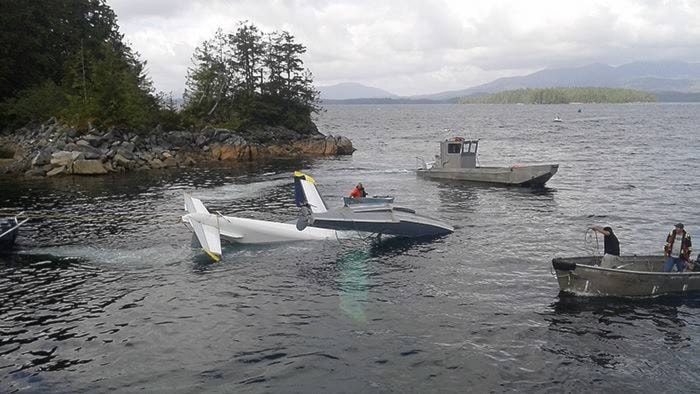An Inland Air pilot’s decision to land a seaplane in gusty crosswind conditions put the aircraft at a higher incident risk, concluded an investigation by the Transportation Safety Board of Canada (TSB).
The seaplane crash occurred on May 24, 2016, with six passengers and one pilot on board.
TSB released its investigation report Monday, Jan. 22. The DeHavilland Beaver seaplane was attempting to land in Kitkatla when its left float struck the water with enough force to bounce back up. This caused the right float to hit the water hard, and the impact broke the float structure. The body of the plane became inverted.
All seven people onboard were able to evacuate while submerged. Nearby boaters were able to rescue the passengers and pilot immediately. However, the report said one of the seaplane’s passengers was seriously injured in the crash.
Bruce MacDonald, owner of Inland Air, said that he was not notified of anyone being seriously injured in the incident.
“I know people ingested some seawater mixed in with a little bit of fuel there and whatnot, but this is news to me with a serious injury. People were immersed in cold water and some people got some in their lungs — I know the pilot did. As far as talking to the insurance company, they never notified me,” MacDonald said.
MacDonald added that it took TSB a long time to finish the report. He said no one from the board came up to the remote area during the investigation.
“I know they interviewed people, but they didn’t actually come up here to investigate the crash,” he said.
The investigation concluded that lower-risk landing options were available at the time. Four out of 10 factors most often cited in seaplane incidents were identified by TSB.
MacDonald said the pilot did not fly over the landing area to survey the conditions and factors, such as debris, wave height and direction. Inland Air standard operational policy has since made flyovers mandatory for seaplane landings.
“It’s the North Coast. The water conditions and wind conditions change from minute to minute,” MacDonald said. “Our pilots have situational awareness of what the water’s doing at the time. It was just a combination of events.”
TSB also discovered other risk-related factors. The Inland Air pilot did not brief the six passengers on the location of emergency exits or making sure the passengers knew what to do in the case of an emergency. The investigation states this led to an increased risk of injury or death to the passengers during the evacuation of the submerged seaplane.
Since the crash, MacDonald said Inland Air has made their safety briefings longer and more detailed.
“We’re making sure people are not fiddling with their seatbelts or talking to each other, and they’re actually paying attention. It’s their life. Passengers need to take a proactive role in it too,” he said.
Even though the 65-year-old has been flying for almost 45 years, MacDonald said whenever he’s a passenger he listens to the brief and counts how many rows are between him and the closest exit so that he can find it in smoke or dark in case he needs to.
“They’re not paying attention. Nobody ever does until there’s an emergency, and then all of a sudden it’s ‘Oh boy, what do I do?’” MacDonald said.
READ MORE: Seaplane crashes upon landing in Kitkatla waters
The passengers were also not wearing personal floatation devices (PFD), but are not required to. MacDonald said PFD regulations, which he expects down the line, need to be done carefully. In a small aircraft, when people are in shock, releasing PFDs prematurely or improperly could impair people from getting out of the aircraft.
As for the crash, MacDonald said, “I’m really grateful that it happened where it did, just because of the proximity to shore and the people of Kitkatla who were bang, right there on that aircraft right away. I’m so grateful that nobody lost their life in the incident.
“We do our very best, my pilots do their best to do everything safely and bring everybody home at the end of the day.”
The pilot left his job at Inland Air last February to fly in Ontario. MacDonald said the pilot’s decision to leave was unrelated to the May 2016 incident.
